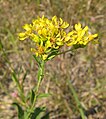Solidago rigida
| Solidago rigida | |
|---|---|

| |
| S. rigida subsp. humilis | |
| Scientific classification | |
| Kingdom: | Plantae |
| Clade: | Tracheophytes |
| Clade: | Angiosperms |
| Clade: | Eudicots |
| Clade: | Asterids |
| Order: | Asterales |
| Family: | Asteraceae |
| Genus: | Solidago |
| Section: | S. sect. Ptarmicoidei |
| Species: | S. rigida
|
| Binomial name | |
| Solidago rigida L. 1753
| |
| Synonyms[1] | |
|
Synonymy
| |
Solidago rigida, known by the common names stiff goldenrod and stiff-leaved goldenrod, is a North American plant species in the family Asteraceae. It has a widespread distribution in Canada and the United States, where it is found primarily east of the Rocky Mountains.[2] It is typically found in open, dry areas associated with calcareous or sandy soil. Habitats include prairies, savannas, and glades.[3]
Description
Soliadgo rigida is a tall, leafy perennial. Its leathery leaves are large for a goldenrod, reaching 3–6 cm (1+1⁄4–2+1⁄4 in) wide and 8–20 cm (3+1⁄4–7+3⁄4 in) long. It produces heads of yellow flowers in the late summer and fall.[3] Its fruit is a wind-dispersed achene.
Subspecies
- Solidago rigida subsp. glabrata (E.L.Braun) S.B.Heard & Semple – southeastern + south-central U.S.
- Solidago rigida subsp. humilis (Porter) S.B.Heard & Semple – central + western Canada, central + western United States as far west as the Rocky Mountains
- Solidago rigida subsp. rigida – Ontario, central + eastern U.S.
Conservation
This species is considered by NatureServe to be globally "secure" (G5), which is the lowest level of conservation concern assigned.[4] However, it is known to be rare on the local level, due to its declining grassland habitat. It is listed as endangered in Connecticut,[5] New Jersey and Pennsylvania. It is listed as endangered and extirpated in Maryland, as threatened in New York, and as historical in Rhode Island.[6]
Native American ethnobotany
The Ojibwe use a decoction of root as an enema,[7] and take an infusion of the root to treat "stoppage of urine".[8] The Meskwaki make the flowers into a lotion and use them on bee stings and for swollen faces.[9]
References
- ^ a b "Solidago rigida". The Plant List. Missouri Botanical Garden. Royal Botanic Gardens, Kew.
{{cite web}}: CS1 maint: others (link) - ^ "Solidago rigida". County-level distribution map from the North American Plant Atlas (NAPA). Biota of North America Program (BONAP). 2014. Retrieved 23 January 2018.
- ^ a b c Semple, John C.; Cook, Rachel E. (2006). "Solidago rigida". In Flora of North America Editorial Committee (ed.). Flora of North America North of Mexico (FNA). Vol. 20. New York and Oxford – via eFloras.org, Missouri Botanical Garden, St. Louis, MO & Harvard University Herbaria, Cambridge, MA.
- ^ Oligoneuron rigidum NatureServe
- ^ "Connecticut's Endangered, Threatened and Special Concern Species 2015". State of Connecticut Department of Energy and Environmental Protection Bureau of Natural Resources. Retrieved 19 January 2018. (Note: This list is newer than the one used by plants.usda.gov and is more up-to-date.)
- ^ USDA, NRCS (n.d.). "Oligoneuron rigidum". The PLANTS Database (plants.usda.gov). Greensboro, North Carolina: National Plant Data Team. Retrieved 19 January 2018.
- ^ Densmore, Frances, 1928, Uses of Plants by the Chippewa Indians, SI-BAE Annual Report #44:273-379, page 364 (Note: This source comes from the Native American ethnobotany database (http://naeb.brit.org/) which lists the plant as Oligoneuron rigidum var. rigidum. Accessed 19 January 2018
- ^ Densmore, Frances, 1928, Uses of Plants by the Chippewa Indians, SI-BAE Annual Report #44:273-379, page 348 (Note: This source comes from the Native American ethnobotany database (http://naeb.brit.org/) which lists the plant as Oligoneuron rigidum var. rigidum. Accessed 19 January 2018
- ^ Smith, Huron H., 1928, Ethnobotany of the Meskwaki Indians, Bulletin of the Public Museum of the City of Milwaukee 4:175-326, page 217218 (Note: This source comes from the Native American ethnobotany database (http://naeb.brit.org/) which lists the plant as Oligoneuron rigidum var. rigidum. Accessed 19 January 2018
Error: "Q15568528" is not a valid Wikidata entity ID.
- CS1 maint: others
- Articles with short description
- Articles with 'species' microformats
- Taxonbars desynced from Wikidata
- Taxonbar pages requiring a Wikidata item
- Taxonbars with invalid from parameters
- Taxonbars without secondary Wikidata taxon IDs
- Solidago
- Plants described in 1753
- Flora of Canada
- Flora of the United States
- Taxa named by Carl Linnaeus
